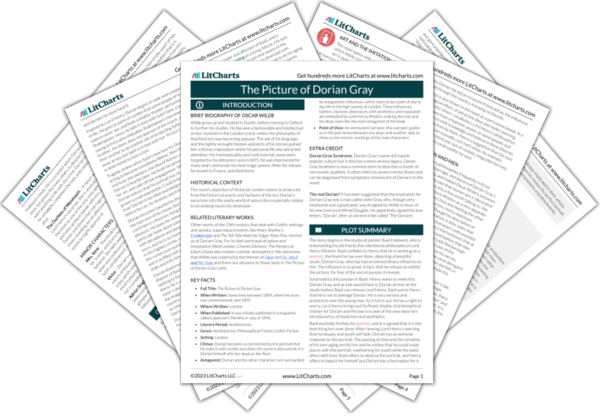Summary
Analysis
The same evening, Dorian, charmingly dressed with violets in his buttonhole, goes calmly to a party held by Lady Narborough, a clever, wily woman with a special fondness for Dorian. She complains good humoredly about her former husband and regrets she could not have married Dorian instead. She is also fed up with her guests, and finds her own daughter and son-in-law dull company. She requests that Dorian sit by her.
How quickly Dorian transforms from a desperate murderer to a vision of loveliness! The society of Henry’s friends is preoccupied again with appearances, and Dorian’s, still unchanged, always secure him the most attention of the group.
Themes
Quiz
Test Yourself
Dorian looks around the room and agrees that the guests are an ugly set. He feels a little cheered when he realizes Lord Henry will be there, but at dinner, he has no appetite and drinks to excess. Henry notices, and inquires after his mood. Lady Narborough interrupts and announces that Dorian is in love. The three of them tease and banter about Dorian’s latest love, Madame de Ferrol, who is on her fourth husband. Lord Henry comments cuttingly that the husbands of beautiful women are mostly criminals. Lady Narborough scolds him. His reputation for wickedness is well deserved.
The guests are rewarded either for attractiveness or for quick wit and cutting humor. And Dorian’s shallow affections for Madame de Ferrol, who is lusted after by most of the men in the set, fulfill the superficiality that creates this dangerous social dynamic. The whole conversation suggests that one cannot both be good and beautiful. Dorian's experience that one cannot be good while being aware of and focused on one's own beauty. But beauty is all these people are focused on.
Themes
Quiz
Test Yourself
She jokes that she ought to marry again to be in fashion, but according to Henry’s theory, women only remarry because they hated their husbands. When Lady Narborough complains that her husband was flawed enough, Lord Henry shares another theory, that women only love flawed men. The three of them agree that the state of the world is faulty. Dorian calls it a disappointment. Narborough insists that Dorian should not be at all tired of life yet, and tells him she will try to marry him off to an eligible girl. She wants him to have a happy marriage. Lord Henry quips that a happy marriage is impossible if you are in love with the girl.
True to form, Henry banters in a way that mocks happiness and goodness. Traditional forms of love, like marriage, are degraded by Henry. Dorian represents youth to them, and a chance for Lady Narborough to enjoy the idea of courtship, and for Lord Henry to enjoy imparting influence. These elders have used and coveted Dorian’s youth for themselves.
Themes
Quiz
Test Yourself
Lady Narborough asks Henry to come and entertain her more often, promising to have better guests in the future. The women get up from the table and withdraw, leaving Henry still spouting his theories. While the other male guests begin a pompous, political discussion, Dorian moves to sit by Lord Henry. Henry talks about the evening they spent together with the Duchess of Monmouth, who is smitten with Dorian. She is an unusual woman, clever and pretty, but unhappily married. Dorian tells Henry that they will see her again at a party he is hosting. He lists the other distinguished guests and Henry is pleased.
There is an obvious divide between the place of women in this society and the place of men, who are catered to and whose discussions take center stage and whose ideas are thrown around and listened to by the women. But the Duchess of Monmouth seems more like one of the men. She stays around during the male post-dinner hour. Perhaps it is her blend of prettiness and wit that allows her to be seen by Dorian and Henry.
Themes
Quiz
Test Yourself
Get the entire The Picture of Dorian Gray LitChart as a printable PDF.

Lord Henry changes the subject and asks Dorian why he left so early the previous evening. Dorian treats the question with nervous suspicion. He apologizes that he is out of sorts, and decides to go straight home. As he leaves, his own loss of control at the mention of the previous evening worries him. When he gets home, he burns Basil’s clothes and bag.
Dorian is struggling to keep his façade – the evidence of his sins seems to be both material and abstract , but though he can destroy the material signs, Basil’s clothes, his own guilt and his failing nerve start to become visible.
Themes
Quiz
Test Yourself
Afterwards, Dorian is overcome with a craving. He goes to a special cabinet, to a particular drawer within, which holds a jeweled Chinese box, and opens it to find a pungent green paste. Dorian dresses in common clothes and rushes outside and finds a cab. The driver refuses to go to the destination Dorian requests, but after Dorian offers more money he agrees.
Veils, coverings and containers symbolize the layers of secrecy and denial that threaten Dorian’s mind. Here, Dorian hides opium within his beautiful objects. On the one hand, opium puts those who use it into a forgetful daze, at once making the world seem like art and allowing someone to forget their past. At the same time, the opium dens of the city are in the worst, seediest parts of town. Clearly Dorian has done all this before—traveled through squalor for the lure of opium.
Themes
Quiz
Test Yourself












